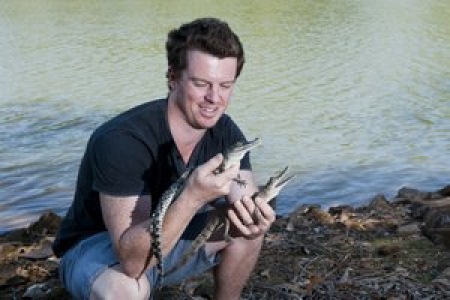Researcher snaps first glimpse of baby croc behaviour
A Charles Darwin University researcher has peered into the murky depths of the behaviour of Northern Australia’s most voracious predator finding their innate survival instinct begins from day one.
Over the past three years, PhD candidate Matthew Brien has set up infrared CCTV cameras to record the never-seen-before behaviour of saltwater and freshwater crocodile hatchlings.
“It is really exciting,” he said. “This is the first time we have really been able to observe the behaviour of baby crocodiles without them sensing we are watching. During the day these animals rest, but once the lights go out it is a whole different story.”
Mr Brien said because of the inherent difficulties associated with observing crocodiles, the footage was researchers’ first real insight into baby crocodilian behaviour and would assist them to build a picture from birth.
“We already know that adult crocodiles have a diverse behavioural repertoire and demonstrate strong parental care like birds, but we have also found that rather than learn their life skills like many other animals they appear to be born with this innate set of behaviours,” he said.
“What we discovered is that crocodiles are born with a natural instinct to fight and gain dominance. When I first watched the footage I was shocked to see the baby saltwater crocodiles fighting in the form of head striking and death rolling each other, just like the adults would in the wild and in captivity. Hatchlings of both species at one week of age, displayed the full repertoire of behaviour displayed by adult crocodiles.”
Mr Brien said although the behaviour of both species was similar in some respects, they had different behavioural strategies, which could be attributed to differences in the level of social tolerance and morphological features.
“The saltwater crocodile is larger with a shorter thicker snout, with hatchlings often head striking or biting each other.
“In comparison, the freshwater crocodile hatchlings would mostly raise their head and snout upwards out of the way and try to press down on their opponent with their upper body, thus avoiding contact and damage to their longer narrower snout.
“While both species seem to communicate through biting, they also employ non-contact strategies to communicate, such as puffing themselves up or rapidly twitching the tail sideways as a warning,” he said.
Mr Brien said this innate aggressive behaviour was especially important in establishing and maintaining dominance hierarchies in saltwater crocodile hatchlings that are characterised by aggression–submission interactions instead of actual fighting.
“It may be important in preventing serious injury in a species equipped with formidable armoury,” he said. “This behaviour and social status may also be a major contributor to the observed differences in growth rates and survival observed for both species in captivity.
“In the life of crocodilians the general rule is, if you are bigger, then you are more dominant,” he said.
CDU wildlife biologist and PhD candidate Matthew Brien has worked on the conservation of crocodiles and snakes all over the world. This research was conducted as part of Mr Brien’s PhD with CDU looking at the survival rates of saltwater crocodile hatchlings in collaboration with Crocodylus Park in Darwin.
